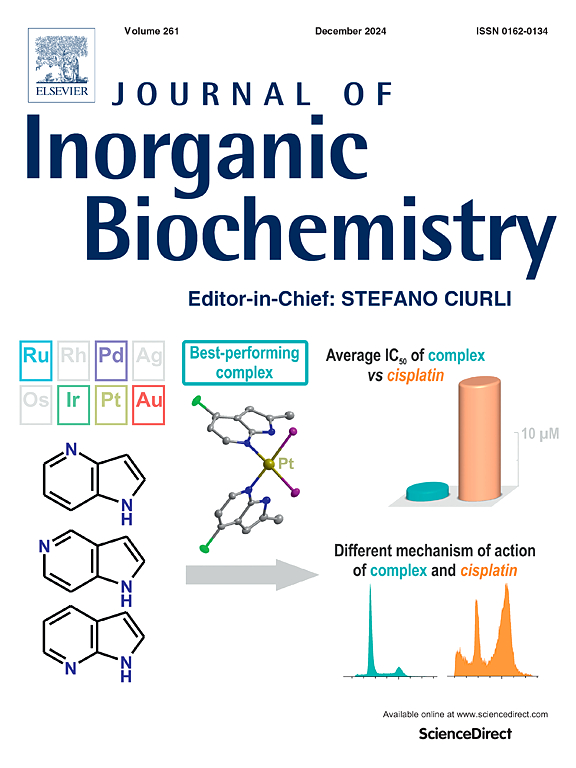钌(II)-巯基复合物通过凋亡途径诱导卵巢癌细胞损伤。
IF 3.8
2区 化学
Q2 BIOCHEMISTRY & MOLECULAR BIOLOGY
引用次数: 0
摘要
卵巢癌是全世界妇女癌症相关死亡的主要原因。化疗药物通常用于治疗患者,钌(II)基化合物已被研究作为铂类药物的可能替代品。在这项工作中,我们研究了三种不同的Ru(II)-膦-巯基络合物(1-3)作为抗A2780和A2780- cisr卵巢癌细胞的潜在细胞毒性药物。观察到2的时间依赖性细胞毒性,也表现出比顺铂对照组更好的选择性。在三维肿瘤球体上观察到类似的细胞毒性行为。虽然没有观察到细胞周期分布的变化,但化合物2影响了A2780细胞的线粒体膜电位,并通过凋亡途径引起细胞死亡,流式细胞术实验证实了这一点。Western blotting实验显示,2能影响p53、PCNA、γ - h2ax和cleaved caspase-3的表达,是一种很有前景的卵巢癌抗癌药物。本文章由计算机程序翻译,如有差异,请以英文原文为准。

Ruthenium(II)-mercapto complexes induce cell damage via apoptosis pathway on ovarian cancer cells
Ovarian cancer represents a leading cause of cancer-related deaths in women worldwide. Chemotherapeutic agents are usually employed to treat the patients, and Ruthenium(II)-based compounds have been investigated as possible substitutes for platinum drugs. In this work, we studied three different Ru(II)-phosphine-mercapto complexes (1–3) as potential cytotoxic agents against A2780 and A2780-cisR ovarian cancer cells. A time-dependent cytotoxicity was observed for 2, which also exhibited better selectivity than cisplatin control. A similar cytotoxic behavior was observed on 3D tumor spheroids. Although no changes were observed in cell cycle distribution, compound 2 affected the mitochondrial membrane potential on A2780 cells, and caused cell death via apoptotic pathway, which was confirmed by flow cytometry assay. Western blotting experiments revealed that 2 affected the expression of p53, PCNA, γH2AX and cleaved caspase-3, making it a promising anticancer agent for ovarian cancer.
求助全文
通过发布文献求助,成功后即可免费获取论文全文。
去求助
来源期刊

Journal of Inorganic Biochemistry
生物-生化与分子生物学
CiteScore
7.00
自引率
10.30%
发文量
336
审稿时长
41 days
期刊介绍:
The Journal of Inorganic Biochemistry is an established international forum for research in all aspects of Biological Inorganic Chemistry. Original papers of a high scientific level are published in the form of Articles (full length papers), Short Communications, Focused Reviews and Bioinorganic Methods. Topics include: the chemistry, structure and function of metalloenzymes; the interaction of inorganic ions and molecules with proteins and nucleic acids; the synthesis and properties of coordination complexes of biological interest including both structural and functional model systems; the function of metal- containing systems in the regulation of gene expression; the role of metals in medicine; the application of spectroscopic methods to determine the structure of metallobiomolecules; the preparation and characterization of metal-based biomaterials; and related systems. The emphasis of the Journal is on the structure and mechanism of action of metallobiomolecules.
 求助内容:
求助内容: 应助结果提醒方式:
应助结果提醒方式:


